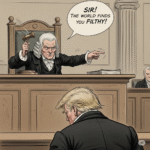Covering-Up the Cover-Up
Deputy Attorney General Todd Blanche will meet with Ghislaine Maxwell. This follows public statements from Attorney General Pam Bondi and President Trump urging the Department of Justice to “release all credible evidence” in the Jeffrey Epstein case. The DOJ’s stated reason for this meeting is to find any new information Maxwell has about others involved in Epstein’s crimes. However, many see this meeting as another move in an ongoing effort to hide the full truth, suggesting a covering-up the cover-up.
A Legacy of Distrust
Public skepticism about the Epstein case is strong, stemming from its contentious history. The 2008 plea deal, which allowed Epstein to avoid serious federal charges, immediately raised questions about protection due to his powerful connections. His subsequent death in a jail cell in 2019 while awaiting trial further fueled widespread disbelief. Many believe he was silenced to prevent him from naming others, creating a lasting cloud of suspicion over the entire affair.
Unanswered Questions and Shifting Narratives
Despite repeated public calls, no clear “client list” has been released, nor have significant new prosecutions of high-profile individuals occurred. A recent DOJ-FBI memo stated no “incriminating ‘client list’” was found and that no further disclosures were “warranted.” This angered many who expected more information. Attorney General Pam Bondi had previously spoken of a “client list” and “tens of thousands of videos.” The DOJ’s later shift from those claims led to accusations of managing public opinion rather than truly revealing facts. The public’s trust in the handling of this case has been severely damaged.
The Echo of Past Suspicions: Intimidation or Information?
This meeting with Maxwell also draws unsettling comparisons to past rumors surrounding the Epstein case. Many recall widespread claims that former Attorney General Bill Barr met with Jeffrey Epstein in prison just before Epstein’s death. It is important to note that these claims were widely debunked by fact-checkers, with the original source later retracting the information. There is no credible public evidence that Barr ever personally visited Epstein in jail. However, the perception of a high-level DOJ interaction with a key figure, followed by a controversial event, created lasting public distrust. The question remains whether those who controlled the situation, like Barr, might have influenced events.
Ghislaine Maxwell, serving a 20-year sentence, would certainly be aware of these persistent rumors. For her, the news of a top DOJ official now requesting a personal meeting could be more than just an offer for information; it could be interpreted as an ominous and potent threat. The specter of Epstein’s death looms large over this case, and the timing of such a meeting might feel like an intimidation tactic—a stark reminder of what can happen when those involved push too hard or don’t cooperate.
Interpreting the Current Meeting
The current meeting with Ghislaine Maxwell, even though publicly announced, triggers a similar feeling for some. Both instances occurred under pressure to address the Epstein case and are viewed through the lens of potential information control. Maxwell is serving a 20-year sentence and was interrogated thoroughly before and during her trial. The idea that she would now offer new, critical information that the DOJ does not already have seems highly unlikely, and suspect to many observers. The public wants clear answers, not just government actions that manage public perception. Until the full scope of the Epstein network is truly uncovered, every action, including this meeting, will likely be viewed as another step in hiding the facts, a continuous effort at covering-up the cover-up.













